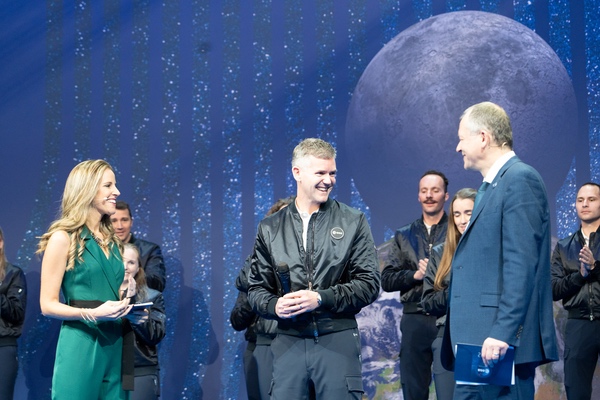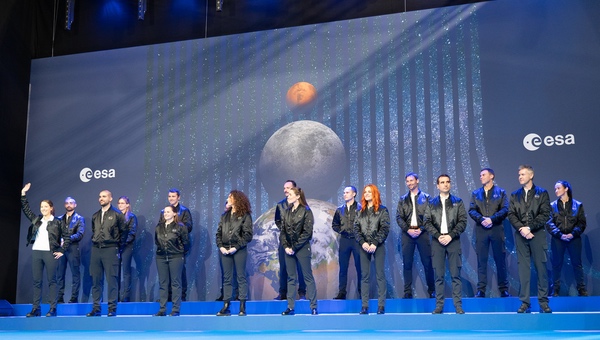Europe selects new astronauts as it weighs its human spaceflight futureby Jeff Foust
|
| Aschbacher said when he invited them to Paris, “you will only find out whether you’re a career astronaut or an astronaut in the reserve pool today, and this is what happened.” |
ESA worked though the various stages of the astronaut selection process: interviews, tests, medical exams, and more, including, for some of the finalists, meeting with the agency’s director general, Josef Aschbacher. That was more than just a perfunctory interview, he said at the event. “I like being the bad cop to really put pressure on them.”
The astronaut announcement took place immediately after the post-ministerial press conference, with only a brief video serving as a buffer between the two. After a few minutes of introductory remarks by Aschbacher, the emcee said, “Do you want to do the honors and lift the curtain?”
“How do I lift the curtain?” he asked.
“On your call,” the emcee said.
“Okay, lift the curtain.” And with that, the backdrop on the stage, which had been in place since the start of the ministerial press conference, raised, revealing nine men and eight women, the new ESA astronaut class.
ESA went into the astronaut selection process intending to select four to six new “career” astronauts, joining the seven currently in the agency’s astronaut corps. However, ESA also intended to select additional “reserve” astronauts. “They will be available for future astronaut activities,” Aschbacher said. Like military reservists, they would keep their fulltime jobs elsewhere, but get some training and could be called up “if opportunities arise, maybe, later on.”
The question was, who among those 17 people were the new career astronauts and who would be in the reserves? Aschbacher said when he invited them to Paris, “you will only find out whether you’re a career astronaut or an astronaut in the reserve pool today, and this is what happened.” It gave the event a reality TV twist; the spaceflight equivalent of a rose ceremony.
The emcee ultimately announced the names of five people who ESA had selected as career astronauts. There were classic choices, overachievers in multiple fields: Sophie Adenot, a French helicopter test pilot and engineer; Pablo Álvarez Fernández, a Spanish engineer who had worked on ESA’s ExoMars mission; Rosemary Coogan, a British astrophysicist and former Royal Navy reservist; Raphaël Liégeois, a Belgian neuroscientist; and Marco Sieber, a Swiss doctor and former paratrooper.
The five had wide-ranging professional and personal accomplishments: the ESA biography of Liégeois noted in passing that he and his wife took a four-month cycling trip from Singapore to Belgium in 2017 “to meet poets across Asia and Europe.” They also had the requisite sense of humor: asked to introduce herself on stage, Coogan said she was “European but from the UK,” a line that generate the loudest laughs (and some applause) from the European audience.
Eleven others would become reserve astronauts. The 17th, and perhaps most intriguing, person on stage was John McFall, a British doctor. He was officially neither a career nor a reserve astronaut but instead a potential “parastronaut” or an astronaut with a physical disability.
| Asked to introduce herself on stage, Coogan said she was “European but from the UK,” a line that generate the loudest laughs (and some applause) from the European audience. |
McFall lost his right leg in a motorcycle accident at age 19, but went on to become a Paralympian in track and field and then a doctor. He said on stage he applied to see if it was possible for someone with a disability like his to fly in space. “I felt compelled to help ESA answer this question: can we get someone with a physical disability to do meaningful work in space?”
ESA announced at the start of the astronaut selection process last year it would consider selecting one or more potential parastronauts as part of a feasibility study. “Being an astronaut is a very exclusive thing to be, but having a disability shouldn’t rule you out,” said David Parker, ESA’s director of human and robotic exploration, at the event. “We are pioneering something here. It’s something we are really excited to be doing.”
That feasibility study will primarily look at safety issues involved with having an astronaut with a disability on a flight. “When you have an emergency on the launch pad, you need to be able to evacuate the vehicle in a very short amount of time,” explained Frank De Winne, head of the European Astronaut Centre and also a former astronaut, during an interview the day before the announcement. “How can we make sure that the parastronaut can fulfill those requirements together with his crew without endangering himself or his crew?”
The feasibility study will include other space agencies who are partners on the International Space Station, like NASA. He suggested that any decision that ESA reaches at the end on whether or not to fly McFall, or other potential parastronauts, will depend on any changes to the station and crew transportation vehicles needed to accommodate parastronauts and the cost associated with those changes.
“We need to find agreement with the international partners, and we need to find if there needs to be vehicle adaptations,” he said.
 John McFall (center), a British doctor who lost his right leg in a motorcycle accident, will participate in a parastronaut feasibility study. (credit: ESA/S. Corvaja) |
Flight opportunities and the future of European human spaceflight
The five career astronauts ESA announced at the ceremony will go to the European Astronaut Centre in Cologne, Germany, early next year for a year of initial training. After that, they will be eligible for flight assignments and the additional training that comes with them.
While ESA has opportunities to send astronauts both to the ISS as well as on Artemis missions, De Winne said the new astronauts would likely be first assigned to the ISS, reserving the Artemis missions for its veteran astronauts that have already flown one or two missions each to the station. For the Artemis missions, he said, “we think it’s prudent we select astronauts that have proven their capabilities and that have already some spaceflight experience under their belts.”
(This is not a viewed shared by all space agencies. Canada, which has a seat on Artemis 2 in exchange for contributing a robotic arm system for the lunar Gateway, will likely fly a rookie astronaut on that mission, simply because three of its current four-person astronaut corps has yet to fly in space.)
ESA has not announced any flight assignments yet for those Artemis missions. Agency officials previously said they expect two of the three seats they currently have from NASA, provided in exchange for contributions to Artemis like Gateway modules, will be on Artemis 4 and 5, the missions that will delivery those Gateway elements. ESA’s commitment to develop other lunar capabilities, notably its Argonaut cargo lander, might enable additional seats, including missions to the lunar surface.
For the ISS, the agency gets, on average, one flight assignment every one and a half years. All of ESA’s current astronauts were at the ceremony in Paris except for Andreas Mogensen, who was in training to go to the space station late next year on the Crew-7 mission. This creates several flight opportunities for the new astronauts through the end of the decade.
| “I hope so,” De Winne said when asked if ESA might realize a decades-long dream of crewed launches from French Guiana. “I think if we don’t do that, it will be very difficult for ESA to maintain its position.” |
However, what happens after 2030, when the ISS is scheduled to be retired, is unclear. De Winne said ESA is starting to think about how it might use commercial space stations like those NASA is developing. “I’m sure we will find a solution, but today the solution does not exist,” he said. “There are many questions about this and this is why I say the next three years—’23, ’24, ’25—are going to be very important.”
He said he expected ESA to decide on its low Earth orbit human spaceflight plans by the next ministerial meeting in 2025. One aspect of that will be how ESA uses those commercial space stations. “We need to see in Europe how do we enter into that world,” he said.
The expectation is that ESA member states will want a similar cadence of flight opportunities and research, but contracted differently. “We need to continue more or less what we do today as the minimum, but then we need to see how we implement that.”
He said one way that ESA might cover its cost of using commercial space stations is to provide transportation to them using a future crewed spacecraft. That could be of interest to companies developing those stations, he said, and more palatable to European governments and industry than paying American companies for those missions.
“If we talk to the commercial providers today,” he said of companies working on commercial space station concepts, “they all tell us the same thing: they are interested in transportation, because they will build a space station but they don’t have the transportation, and for them to keep the costs low on transportation, they want competition. It’s as simple as that.”
That would require ESA to fund a human spaceflight program, something that agency leaders like Aschbacher have identified as a potential future “inspirator” effort but which is not funded. “Europe has not rocket that can bring astronauts into space,” he said in a talk last week at a Space Transportation Association luncheon in Washington. “I’m restarting the debate on whether Europe should have such a capability.”
That debate, he said, will continue through a second space summit scheduled for late next year, building upon the first space summit held in February. “We have to see how far politicians are willing to look into this,” he said. “Does Europe want to be more independent, more autonomous in human space transportation?”
De Winne, the former astronaut, is among those who wants European governments to take a bigger role in human spaceflight. “I hope so,” De Winne said when asked if that strategy might realize a decades-long dream of crewed launches from French Guiana. “I think if we don’t do that, it will be very difficult for ESA to maintain its position.”
In the meantime, at least one ESA member is taking a shortcut for human spaceflight. In comments at the ministerial meeting, Péter Szijjártó, Hungary’s foreign minister, confirmed the country was planning to fly an astronaut through Axiom Space, the American commercial spaceflight company, building upon a memorandum of understanding the Hungarian government signed with the company in July.
He said the country was already well advanced in the astronaut selection process, having received 244 applications, 39 of which were from women. That has been narrowed down to eight candidates, with four picked by the end of the year to go into training. The government planned to select the person who would fly on the mission just a few months before the flight, tentatively scheduled for late 2024 or early 2025, pending NASA’s approval of Axiom’s proposal for the private astronaut mission.
Szijjártó’s comments, made as he and ministers from ESA’s other member states made opening remarks in the opening public session of the meeting, struck some by surprise. In particular, he said Hungary was spending $100 million on the overall effort. The country ended up committing €87 million ($91 million) to ESA programs over the next three years, €10 million less than what it contributed in 2019.
No Hungarians were included in the class of 17 astronauts ESA announced after the ministerial concluded. However, the astronaut the country selects will likely go to the ISS before any members of that new ESA astronaut class get to fly.
Note: we are using a new commenting system, which may require you to create a new account.
